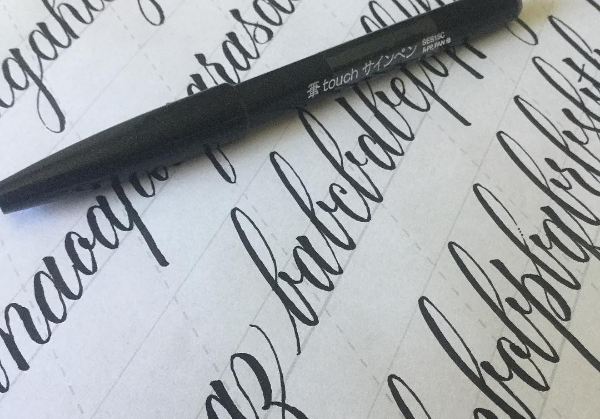
So you want to learn calligraphy? And you want to get good at it quickly? There’s no “instant download” shortcut, alas, but this series of articles will tell you how to get better faster.
Whether you want to learn brush lettering, pointed pen calligraphy (Copperplate, Spencerian, or more modern styles), Italic, Uncial, Blackletter, or any other calligraphy or lettering style, I’m sure you know it takes practice.
But not just any practice. Effective practice.
Good practice habits lead to beautiful letterforms. Follow these tips, and you’ll get better at calligraphy a lot faster.
How to Get Good at Calligraphy FAST: The 4 C’s of Effective Calligraphy Practice
1. Conscious Practice
Practice makes permanent (not necessarily perfect!), so in order to develop good habits it is most important to practice with conscious intention.
Jotting off a few letters quickly and sloppily will develop sloppy calligraphy. Instead, work with full concentration and care, whether it’s for five minutes or five hours.
After you finish a letter or a word, stop and analyze it — compare it to the model on the exemplar and ask yourself what is working and what isn’t. How does your letter vary from the exemplar?
Then consciously try to improve any weaknesses when you put your pen back to the paper.
If you practice in this way — making a conscious effort to improve each and every letter you write, every time you sit down to letter — you’ll get better a lot faster than if you just write a string of letters across the page, each one duplicating the mistakes of the previous ones.
 It can be hard to really see the shapes of the letters, though, so to help you see better, check out this post about 10 things to watch out for.
It can be hard to really see the shapes of the letters, though, so to help you see better, check out this post about 10 things to watch out for.
2. Consistent Practice
You will see the fastest improvement if you practice on a consistent basis. Even five minutes a day will make a difference in your calligraphy!
The ideal is to practice regularly, and I always recommend making your time commitment ridiculously achievable.
In other words, make it so small that you can’t not do it!
It may seem silly to commit to five minutes or fifteen minutes, but you’ll be amazed at the progress you can make if you stick with it. And fifteen minutes of conscious practice every day for a week is much better than two straight hours, one day a week.
And any amount of practice is better than none!
Although it may sound counter-intuitive, this is one reason it’s so important not to beat yourself up if you miss a day. Just get right back on track the next day.
As I like to say:
Don’t beat yourself up, LOVE yourself up! (Click to tweet.)
Studies have shown that people who respond to a failure with self-compassion are dramatically more likely to achieve their goals than those who beat themselves up.
This isn’t really surprising if you look at it logically: if you know you’re going to get a beating if you stumble (from yourself!), and you know you’re going to stumble at some point (because you’re human!), it becomes safer to just stop trying.
So when you stumble, don’t beat yourself up!
That includes NOT doubling up on your commitment for the next day.
If you do miss a day, never double up on your commitment for tomorrow!
Why? Because adding today’s skipped fifteen minutes to tomorrow’s fifteen minutes is a form of beating yourself up.
It also makes your ridiculously achievable goal suddenly a lot less achievable. And that means you’ll be more likely to fail (again). Which would lead to an even less achievable goal the next day.
And that would almost invariably result in a long string of failures.
And that sends a message to your brain that “I’m a failure.”
This is never helpful!
It’s so much better to keep your commitment tiny, ridiculously achievable, and just take a fresh start and get right back on track when you stumble.
Remember, this is supposed to be FUN! And remember:
Of all the practices we engage in, the most important practice of all is just getting back on the wagon. (Click to tweet.)
3. Contextual Practice
When you’re first learning a particular calligraphy alphabet, you’ll want to focus on one letter at a time. But tempting as it may be to fill a page with a’s before moving onto b’s, doing so is likely to just reinforce your mistakes (see #1 above!)
Instead, it’s a good rule of thumb to write a letter no more than three times in a row before moving on to the next letter.
Once you have a general sense of all the letters in a calligraphy alphabet, start putting letters together in words and sentences. Good calligraphy is just as much — if not more! — about good spacing and rhythm as it is about good letterforms, and spacing and rhythm can only be learned by practicing writing words.
Here are three ideas for contextual calligraphy practice that you can do almost off the top of your head:
• Write letter “necklaces”
A necklace is an unbroken string of letters. This is a great way to practice combining each letter of the alphabet with every other letter:
aaabacadaeafagahaiaj…
babbbcbdbebfbgbhbibj…
cacbcccdcecfcgchcicj…
etc.
• Write alphabet sentences
An alphabet sentence (or pangram) is a sentence that uses every single letter of the alphabet at least once. Obviously alphabet sentences are beloved by calligraphers for practicing!
Perhaps the most famous alphabet sentence is “The quick brown fox jumps over the lazy dog,” but there are dozens of others. The shortest English alphabet sentence I know of that actually (sort of) makes sense, is “Sphinx of black quartz, judge my vow.”
• Write alphabet lists
Pick a category, any category, and write out 26 items from that category in alphabetical order. This is a great way to practice writing capitalized words!
Aardvark, Bear, Cat, Dog, Elephant…
Aster, Begonia, Chrysanthemum, Daffodil, Edelweiss…
Aureolin, Black, Cerulean, Damson, Ebony…
4. Clean Practice
Treat your calligraphy practice sheets as if they were finished pieces.
If you come away with something attractive in the end, you’ll feel better about your practice session, even if you’re not happy with individual letters or words. So get into the habit of making a neat practice sheet that presents and aesthetic overall image.
Whether you’re using grid or practice paper, or good quality paper (and I do recommend spending at least some of your time practicing on good quality paper, so you get the feel of writing on good quality paper!), here are a couple of suggestions:
Rule up generous margins. Lots of white space around your lettering is so much more pleasing on the eye than a cramped page.
Fill your sheet in a pleasing way. Don’t cross out letters and words. It doesn’t matter what you write, and don’t worry if you spell something wrong — just keep right on going.
So there you have it — the 4 C’s of effective calligraphy practice! Making sure your practice is Conscious, Consistent, Contextual, and Clean, is the fastest way to get better at calligraphy.
Meanwhile, be sure to look at good calligraphy as often as you can. Although it’s no substitute for actual writing, learning calligraphy is as much about training your eye as it is about training your hand. Filling your visual well with examples of beautiful letterforms will help your eye start to recognize good calligraphy from bad.
I hope this is helpful! Go get lettering!
For more hand-lettering tips, check out this epic post on 10 Things to Watch Out For when you practice, to get better at calligraphy fast.

PS — Pssst! Know someone who might benefit from seeing this today? Pass it on!





Leave a Reply